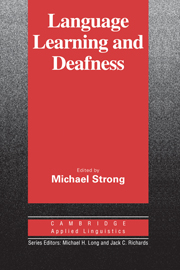Book contents
- Frontmatter
- Contents
- List of contributors
- Series editors' preface
- Preface
- SECTION I THEORETICAL ISSUES
- Chapter 1 Language varieties in the deaf population and their acquisition by children and adults
- Chapter 2 American Sign Language and the human biological capacity for language
- Chapter 3 The history of language use in the education of the Deaf in the United States
- Chapter 4 Sign language instruction and its implications for the Deaf
- Chapter 5 A bilingual approach to the education of young deaf children: ASL and English
- SECTION II RESEARCH REPORTS
- Index
Chapter 4 - Sign language instruction and its implications for the Deaf
Published online by Cambridge University Press: 05 October 2012
- Frontmatter
- Contents
- List of contributors
- Series editors' preface
- Preface
- SECTION I THEORETICAL ISSUES
- Chapter 1 Language varieties in the deaf population and their acquisition by children and adults
- Chapter 2 American Sign Language and the human biological capacity for language
- Chapter 3 The history of language use in the education of the Deaf in the United States
- Chapter 4 Sign language instruction and its implications for the Deaf
- Chapter 5 A bilingual approach to the education of young deaf children: ASL and English
- SECTION II RESEARCH REPORTS
- Index
Summary
Editor's introduction
Rudser describes the history of sign language instruction in the United States and paints a rather gloomy picture of the state of affairs today, particularly with regard to the training of interpreters. Rudser identifies three distinct groups of people who seek sign language instruction: hearing parents of deaf children, teachers of the deaf, and students of sign language interpreting. Each of these groups has different needs with regard to the kind of sign language, level of skill, and term of instruction. Rudser, himself an experienced interpreter fluent in ASL and signed English, takes strong positions on many of the issues he raises. He argues that hearing parents, in the interests of speed, are best advised to learn PSE (although it seems he feels ASL might be ideally more appropriate). He maintains that teachers must have ASL as well as English in order to communicate more effectively with their students and use ASL as a medium of instruction, a point also made by Lou in Chapter 3 with regard to Total Communication. Rudser is concerned that the procedures used in training and selecting sign language interpreters are not as rigorous as those for spoken language interpreters. Higher entrance standards and a longer training program (in conjunction, presumably, with higher rates of pay) might serve both to raise the level of interpreting and to facilitate integration between the Deaf and Hearing populations.
- Type
- Chapter
- Information
- Language Learning and Deafness , pp. 99 - 112Publisher: Cambridge University PressPrint publication year: 1988



